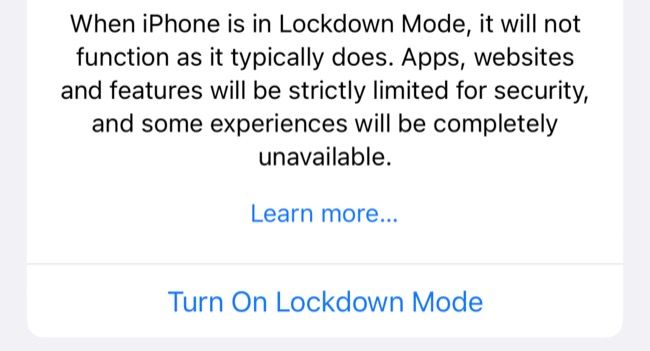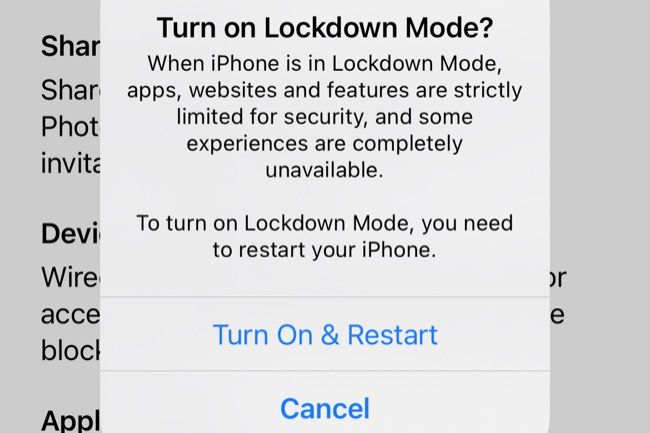Quick Links
Lockdown Mode places heavy restrictions on your iPhone, iPad, or Mac in a bid to boost security. But who is it aimed at, how does it work, how do you enable it, and what kind of drawbacks are there?
At the time of writing in September 2022, this feature is available on the iPhone with iOS 16, However, it isn't available on the iPad until iPadOS 16.1 launches later in fall 2022. Until it arrives, you won't have access to Lockdown Mode on your iPad. Also, macOS Ventura isn't available as of mid-September 2022 but is expected for release in October 2022.
What is Lockdown Mode?
Apple describes Lockdown Mode as "specialized additional protection to users who may be at risk of highly targeted cyberattacks from private companies developing state-sponsored mercenary spyware" and admits the mode has been designed to benefit a "very small number of users."
This extreme level of protection is designed to benefit those at risk of being tracked by governments or private companies using tools like the NSO Group's Pegasus spyware. Apple is in the process of suing NSO Group in a move it hopes will "curb the abuse of state-sponsored spyware."
Once enabled, Lockdown Mode limits many standard features in a bid to limit points of entry for potential spyware. This includes:
- Blocking most message attachment types (excluding images).
- Disabling link previews in messages.
- Turning off "just-in-time" (JIT) JavaScript elements unless you exclude a trusted website.
- Blocking incoming invitations, service requests, and FaceTime calls from unknown contacts (unless you have previously initiated contact).
- Limiting wired connections with computers and accessories.
- Removing Shared Albums from Photos.
- Preventing a device from being enrolled in mobile device management (MDM) as used by many company devices.
- Preventing a device from installing configuration profiles, like those used to preview beta versions of iOS.
Apple states that these restrictions are included in Lockdown Mode "at launch" which could suggest that the company intends to include more restrictions in future releases.
Available With iOS 16, iPadOS 16.1 and macOS Ventura
Lockdown Mode is available to all iPhones and iPads compatible with iOS 16 and iPadOS 16 and all Mac models compatible with macOS Ventura. That means the iPhone 8 and second-generation iPhone SE or newer, the fifth-generation iPad and iPad mini, the third-generation iPad Air, and all models of iPad Pro.
You'll need to update your iPhone, iPad, or Mac using the Software Update feature before you can use Lockdown Mode. If you have an older device that isn't compatible with the update, you may still get security updates to close known vulnerabilities but you'll miss out on this newer extreme level of protection.
How to Enable Lockdown Mode
Enabling Lockdown Mode is easy, regardless of which device you are using. On an iPhone or iPad, head to the Settings > Privacy & Security menu, then scroll down to the bottom of the screen and tap on the "Lockdown Mode" followed by the "Turn on Lockdown Mode" button.
You'll now see a pop-up window that notifies you of the restrictions you're about to enable. To continue, use the "Turn on Lockdown Mode" button then hit "Turn On & Restart" to confirm your decision.
On a Mac, the process is almost identical. Head to System Settings > Privacy & Security, then click on "Lockdown Mode" followed by "Turn On" before being invited to restart your Mac.
Once your iPhone, iPad, or Mac has been restarted, you will now have Lockdown Mode enabled. You can turn it off again by visiting the "Privacy & Security" menu and reversing your decision.
A Balance of Security and Privacy
Lockdown Mode is a security feature that hopes to prevent your device from being compromised by zero-day exploits. As a result of its restrictive nature, the use of Lockdown Mode leaves something of a fingerprint that could expose those who are using it.
The Electronic Frontier Foundation (EFF) disclosed that its web fingerprinting tool Cover Your Tracks could detect when an iPhone owner was using Lockdown Mode on account of restrictions introduced to the Safari browser.
The EFF explained that Lockdown Mode limits potential points of entry that could become targets for spyware and other malware authors. One of these is the ability to load custom fonts, which can be used to exploit a web browser's rendering engine. The EFF noted that it's easy to use JavaScript to detect whether or not a font is being blocked.
Combined with the browser's user agent and other device information left behind when a web page is visited, the EFF was able to ascertain that an iPhone owner is indeed using Lockdown Mode. The concern here is that it could paint a target on an individual's back, drawing attention not for the information left behind but for the way Lockdown Mode attempts to secure their device.
This illustrates one drawback to using Lockdown Mode in that it betrays a user's privacy in a bid to boost overall security. The EFF goes on to say that "Apple's introduction of this powerful new protection is a welcome development for those that need it the most" but that "users should also be aware of the information they are exposing to the web" if they choose to turn it on.
If you're curious about online privacy and how trackers view your browser, test your browser with the Cover Your Tracks tool.
Lockdown Mode Is Unnecessary for Most
The good news is that the vast majority of people do not need to worry about Lockdown Mode. Apple states that "very few" people are subject to the sort of attacks that this mode is designed to prevent, and most can go on using their iPhone, iPad, and Mac to the fullest extent.
Forget Lockdown Mode for now and check out the best iOS 16 features that you should try out right away.





